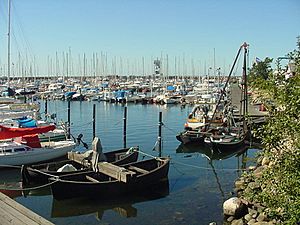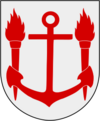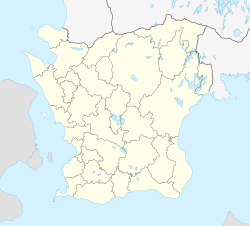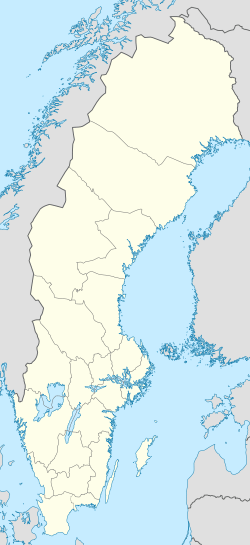Höganäs facts for kids
Quick facts for kids
Höganäs
|
||
|---|---|---|

Höganäs harbour in September 2002
|
||
|
||
| Country | Sweden | |
| Province | Scania | |
| County | Scania County | |
| Municipality | Höganäs Municipality | |
| Area | ||
| • Total | 182 km2 (70 sq mi) | |
| Population
(31 December 2010)
|
||
| • Total | 24,608 | |
| • Density | 1,595/km2 (4,130/sq mi) | |
| Time zone | UTC+1 (CET) | |
| • Summer (DST) | UTC+2 (CEST) | |
Höganäs (Swedish pronunciation: [ˈhø̂ːɡaˌnɛːs]) is a town located in Sweden. It is found in Scania County and is the main town of Höganäs Municipality. In 2010, about 14,107 people lived there.
Höganäs is famous across Sweden for its ceramics industry, especially a company called Höganäs Keramik. This company makes many well-known ceramic products. It is part of the Iittala Group.
The town is also home to the main office of Höganäs AB. This company is one of the world's largest makers of iron powder. It has offices and factories all over the world. Count Eric Ruuth started Höganäs AB in 1797, making it one of Sweden's oldest companies.
Contents
Höganäs: A Journey Through Time
Höganäs started as a small fishing village. Records from 1488 show it was called Høyenæss. By the mid-1600s, it had only 17 homes.
From Fishing to Mining
Later, people discovered coal in the area. Mining began in 1797. To move the coal, a special railway was built in 1798. This railway used wooden rails and was the first of its kind in Sweden. It carried coal from the mine to the harbour.
As mining grew, more people moved to Höganäs. New homes were built for the miners.
The Rise of Ceramics
During the 1800s, more factories opened. These factories used clay from the area to make ceramic products. Höganäs is still very famous for its ceramics today. The coal mines, however, closed down in the 1960s.
Becoming a City
In 1936, Höganäs officially became a city. At that time, it had 6,915 residents. Since 1971, it has been the main town for Höganäs Municipality. This municipality includes the beautiful Kullaberg peninsula and has about 24,000 people living in it.
Accepting the Euro
In 2009, Höganäs started a special project. Many shops, restaurants, and banks in the city began accepting the euro currency. This was a way to welcome visitors and make shopping easier for them.
Gallery
See also
 In Spanish: Höganäs para niños
In Spanish: Höganäs para niños










